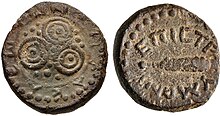Heraclea Sintica
Ancient Greek: Ἡράκλεια Σιντική | |
 | |
| Alternative name | Heraclea Strymonike |
|---|---|
| Location | Blagoevgrad Province, Bulgaria |
| Coordinates | 41°27′01″N 23°15′52″E / 41.4502434992°N 23.264466914°E |
| Type | Settlement |
| Part of | Macedonia, Ancient Rome |
| History | |
| Founded | 356–339 BC |
| Abandoned | c. 500 AD |
| Cultures | Macedonian, Greco-Roman |
| Site notes | |
| Condition | Ruined |
| Public access | Yes |
| Website | https://petrichhistorymuseum.bg/ (in Bulgarian) |
Heraclea Sintica (Ancient Greek: Ἡράκλεια Σιντική, romanized: Hērákleia Sintikḗ), also known as Heraclea Strymonike, was an ancient Greek city located near what is now the village of Rupite in the modern region of Pirin Macedonia in modern south-western Bulgaria.
History
[edit]Heraclea Sintica was founded sometime between 356 and 339 BC by Philip II of Macedon with Macedonian settlers from Heraclea in Mygdonia.[1] This settlement may have replaced a previous Thracian tribal center called Sintia as the Roman historian Livy emphasized that Heraclea lay within the territories of the Sintoi. These people were evidently chased away at the city's foundation, however, as Appian included the Sintoi with the Dardanians and Enetoi as tribes outside the province of Macedonia. Moreover, there is a conspicuous absence of Thracian names among inscriptions from Heraclea which also suggests that the Sintoi had been driven out of the Strymon Valley and that they did not intermix with the colonizers.[2]
The general Asclepiodotus of Heraclea was a native. Demetrius, son of Philip V of Macedon, was slain at Heraclea Sintica.[3] Coins minted here in antiquity have survived.[4]
A powerful earthquake around 425 AD destroyed the majority of the city's infrastructure, including the civic basilica, and also caused the nearby Strumeshnitsa River to flood the forum. After 457 AD, groups of people returned to live in the ruins, but life in Heraclea gradually dissipated with no indications of permanent habitation by 500 AD.[5]
The polis was identified by Assoc. Prof. Georgi Mitrev (University of Plovdiv) after the accidental discovery of a large Latin inscription in 2002. In essence, this is letter of Emperor Galerius and Caesar Maximinus II from 308 AD in which the rulers are turning to Herakleians in response to their request to reclaim the lost city rights. Before 2005, Mitrev published another inscription, which mentions Guy Lucius Skotussaios and Harakleios. It proves conclusively that this is precisely Heraclea Sintica, not another Herculaneum or Heraclea, as this name is very popular in the ancient world.
Since 2007 archaeological excavations have been taking place at Heraclea Sintica, led by Assoc. Prof. Lyudmil Vagalinski, of the National Institute with Museum of Archaeology in Sofia. They noticed strange structures above it: tunnels and an arch. Later on, after geosonar examination by Russian specialists, a large studio for producing ceramic masks for an unknown and as yet unrevealed ancient theatre was discovered.
In 2024, excavations in an ancient sewer revealed most of a marble statue that had been placed carefully in the sewer and then covered with soil. Initial archaeological investigations suggest that it is a vestage of pagan religion that became outlawed upon establishment of Christianity as the local religion at one point and that citizens buried the statue of the deity rather than destroy it.[6] Further excavations are planned to reveal the complete statue, to make it available for further research, and to remove it for placement in a museum.[7]
See also
[edit]References
[edit]Citations
[edit]- ^ Vagalinski, Lyudmil; Nankov, Emil, eds. (2015). Heraclea Sintica: From Hellenistic Polis to Roman Civitas (4th c. BC – 6th c. AD) (2nd ed.). Sofia: America for Bulgaria Foundation. p. 25. ISSN 2367-5640.
- ^ Vagalinski. 2015, pp. 48–49.
- ^ Livy. Ab urbe condita Libri [History of Rome]. Vol. 40.24.
- ^
 Smith, William, ed. (1854–1857). "Heraclea Sintica". Dictionary of Greek and Roman Geography. London: John Murray.
Smith, William, ed. (1854–1857). "Heraclea Sintica". Dictionary of Greek and Roman Geography. London: John Murray.
- ^ Vagalinski, Lyudmil (2020). "The End of Heraclea Sintica". In Popovic, Ivana; Petkovic, Sofija (eds.). ILLYRICVM Romanvm : studiola in honorem Miloje Vasic. Belgrade: Institute of Archaeology. pp. 214–222. ISBN 978-86-6439-054-5.
- ^ Complete Hermes statue found in ancient sewer, July 6, 2024
- ^ Feldman, Ella, Archaeologists Stumble Upon Marble Statue of Greek God in Ancient Sewer, Smithsonian, July 9, 2024
Bibliography
[edit]- Claude Lepelley: Une inscription ďHeraclea Sintica (Macédoine) récemment découverte, révélant un rescrit de ľempereur Galère restituant ses droits à la cite. in: Zeitschrift für Papyrologie und Epigraphik, 146 (2004), 221–231.
- Georgi Mitrev: Civitas Heracleotarum. Heracleia Sintica or the Ancient City at the Village of Rupite (Bulgaria). in: Zeitschrift für Papyrologie und Epigraphik, 145 (2003), 263–272.
- Georgi Mitrev: On Skotoussa and „Scotusaei liberi” from the valley of the Strymon River. in: Arheologia Bulgarica, XII (2008), 2, 47–58.
- Konrat Ziegler und Walter Sontheimer (Hrsg.): Der Kleine Pauly Bd. 2 (1975), Sp. 1034–1035.
- Emil Nankov: “In Search of a Founder and the Early Years of Heraclea Sintica,” In: Vagalinski, L. and Nankov, E. (eds.) Heraclea Sintica: from Hellenistic polis to Roman civitas (4th c. BC-6th c. AD), Proceedings from a conference at Petrich, September 19–21, 2013, Papers of the American Research Center in Sofia, vol. 2, 7–35.
- Archaeological sites in Bulgaria
- Thracian archaeological sites in Bulgaria
- Roman sites in Bulgaria
- Populated places in ancient Macedonia
- Populated places in ancient Thrace
- Argead colonies
- Argead colonies in Macedonia
- History of Blagoevgrad Province
- Former populated places in Bulgaria
- Cities in ancient Macedonia
- Ancient Thrace geography stubs
- Blagoevgrad Province geography stubs


